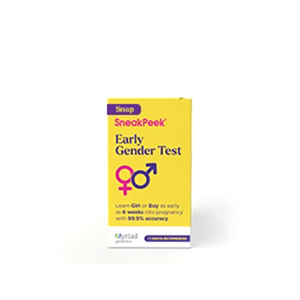Published on May 1st, 2023 and Updated on February 29th, 2024
Check out SneakPeek Gender Test to find out your baby’s gender as early as 6 weeks at over 99% accuracy1!
If you’re trying for a baby, you may have already gone deep down an internet rabbit hole researching ways to optimize your chances of conception. Fortunately, the most effective methods for doing so happen to be the most mundane—including tracking your BBT, or basal body temperature.
As you track basal body temperature, keep in mind that it requires a degree (pun intended) more commitment than other family planning strategies, it can also be an incredibly accurate way of gauging fertility cycles when done right.
Whether you’re trying to nail down your fertility window to promote or prevent pregnancy, we’ll break down how to take basal body temperature with accuracy and ease below.
What is basal body temperature?
Measuring basal body temperature, or BBT for short, describes the lowest temperature a healthy body reaches while in a state of undisturbed rest. This is distinct from the type of measurement you might have taken at a doctor’s office or when feeling under the weather, which gauges your body’s temperature change in a state of activity (sick or healthy!).
As a fertility awareness method, BBT can be tracked for the purposes of:
- Preventing unwanted pregnancy
- Becoming more fluent in your body’s reproductive rhythms
- Tracking ovulation so you know when you’re most likely to conceive (a period referred to as your fertile window)
When most women ovulate, their basal body temperature makes a tiny “jump” by an average of ½ or 1 degree Fahrenheit. Most women’s highest chance of conception is 2 to 3 days before this little temperature leap takes off.
Unfortunately, this wee incline in BBT is too subtle to feel firsthand (remember, we’re talking demi-degrees here). However, it can be observed by a specially-designed basal body temperature thermometer, which you can easily and affordably pick up online.
Are BBT and regular body temperature different?
Put simply, yes—even if they only differ by a fraction of a degree. The main difference between them is that BBT describes an inactive body, while regular body temperature describes the body in a waking, active state.
For most of medical history, the standard temperature of a wakeful body was 98.6ºF, or 37ºC. In recent years, however, researchers have lowered the benchmark to hover between 97.5ºF/36.4ºC and 97.9ºF/36.6ºC.
That said, when it comes to tracking BBT, the numeric value of your regular body temperature isn’t terribly important. What does matter is pinpointing the day you notice your regular temperature scoot up an interval, indicating that an egg has exited the hatch (erm, your ovary).
How to Take Your Basal Body Temperature, Step by Step
There are three golden rules for obtaining an accurate BBT reading:
- Take your temperature regularly (meaning, every day)
- Take your temperature immediately upon waking (and at the same time each day)
- Take your temperature before you engage in any other activities (so no scooting off to the bathroom to pee “real quick”)
If you can adhere to these guidelines with consistency and commitment, you should wind up with an accurate ledger of your fertile window after 3 months of logging. Let’s take a look at precisely the steps you’ll take to get there.
#1 Purchase a BBT Thermometer
Sadly, you won’t be able to use your trusty 20-year-old thermometer as your BBT buddy. You’ll need to purchase a special thermometer designed to measure BBT. These thermometers:
- Are sensitive enough to measure temperature by the decimal
- Typically require a longer time to read the temperature once inserted
A solid BBT thermometer won’t break the bank; they typically cost between $20 and $30. Like a normal thermometer, they may be inserted into the mouth, rectum, or vagina. No area is more accurate for measuring temperature than another, and most people collect their data via the easy, familiar route: under the tongue.
#2 Create a Tracking System
Next, you’ll want to settle on a method for accurate bookkeeping that’s a breeze to maintain. Your most basic options include:
- An analog notebook kept on your bedside table
- A note-taking app on your phone
As for a non-basic option? Most of today’s BBT thermometers are digital, which means many are capable of automatically recording your BBT for you. Not only that, but many models can also share your data with an accompanying app and render them on graphs that depict your monthly cycles!
Understandably, some women have grievances surrounding BBT apps, like data protection and privacy concerns, particularly when collecting such intimate data.
However, others simply find these technologies more comfortable—remember, you may be waking up early to capture an accurate BBT. If you’re a light sleeper, automatic, app-based BBT logs could make it easier to fall back asleep once you’ve taken your temperature.
#3 Set an Alarm
As BBT rule #2 suggests, it’s critical to take your temperature at the same time each day to rule out fluke results. Unfortunately, for your sleep schedule, the most effective time to take your temperature is well before you normally stir awake. This is because:
- You’ll cultivate consistency, even if your normal sleep schedule is inconsistent. (For example, many people sleep later on weekends than on weekdays.)
- It will minimize the chances that you’ll blemish your results if you accidentally wake up a little bit too early on an off day.
You’ll have the most accurate results if you’ve stayed asleep for a solid 5 hours before waking. For most people, this means a viable time to set an alarm is between 5:00 am and 6:00 am.
#4 Take Note of Any Abnormalities
BBT can sketch a very accurate picture of your fertility cycles, but it isn’t foolproof. A slew of factors, both highly common and rare, can influence your measuring basal body temperature and cause inaccuracies in your data. A few include:
- Getting sick
- Drinking alcohol
- The temperature of your sleeping environment
- Excessive stress
- Changes in your routine (e.g., shift work)
- Gynecological conditions
- Being jet lagged
- Certain medicines
- Electric blankets
That said, life happens. If you’re taking your BBT the morning after a Happy Hour or stomach bug, make a note of it in your ledger. You’ll achieve the most reliable results from a cumulative effort by tracking for 3 months or more.
When am I most fertile?
In tracking BBT, many people assume they’re most fertile right after their BBT hikes up a notch. But your fertile window lies in the 2 to 3 days before that monthly uptick, and the best days to try for a baby are 4 days before and 1 day after you ovulate.
Yes, it’s a narrow window—which is why it’s so crucial to rack up at least 3 months’ worth of data to ensure you’re on the right track.
How accurate is BBT Tracking?
BBT tracking can be a supportive modality for getting pregnant, but it’s not a dependable way of predicting ovulation cycles. As many as ¼ of women are estimated to have an irregular menstrual cycle that fluctuates in length. To that end, it’s perfectly normal to see your fertility window shift from month to month.
In a similar vein, BBT tracking may be more useful to some women than others, depending on their typical sleep habits. You may find this method less effective and accurate if you struggle with any of the following:
- Disturbed sleep or insomnia
- Anxiety that interferes with sleep
- A tendency to stir in the night (being a “light sleeper”)
- Taking trips to the bathroom at night
How else can I track ovulation?
Whether used to get pregnant or prevent pregnancy, BBT tracking belongs to a category of similar self-monitoring practices known as Fertility Awareness Methods (FAM) of family planning. Other FAM strategies include:
- Cervical mucus monitoring – Changes in the consistency of your vaginal discharge can tell you a lot about when you’re most fertile. As a general rule, thin or creamy discharge indicates low fertility, while stringy, clear discharge indicates high fertility.
- Cervix position monitoring – The cervix changes its height at different points in a menstrual month, so this method requires you to feel your cervix height manually to determine your fertility levels. Women are most fertile when the cervix is high up and feels soft and pliable to the touch.
- Fertility monitors – Fertility tracking monitors are a type of hormone measurement technology that can gauge levels of fertility hormones in your saliva, urine, or cervical mucus. They include wearable devices, as well as monitors you use to test fluids like pee.
Whichever method you opt for, it’s always best to use at least one other FAM to strengthen the results of your BBT tracking efforts. The higher-quality data you can gather, the better you’ll estimate your fertile window, and the closer you’ll be to your future bundle! Additionally, your BBT tracking efforts set you on the right track for what happens at your first prenatal appointment.
Get Results You Can Trust with SneakPeek
When you’re planning for a baby, it’s easy to become overwhelmed by all the questions and facts that arise. Grounding yourself in what you do know—that you can’t wait to meet your child—can help you stay centered as you set out on this new chapter
Once your bundle is on the way, check out SneakPeek’s Early Gender DNA Test. With this at-home gender blood test, you can learn your baby’s sex a mere 6 weeks into your pregnancy—long before your first-trimester ultrasound—with over 99% accurate1, clinically proven results.
At SneakPeek, every SneakPeek test is processed through CLIA-certified labs on the same day we get your sample. Your results are physician-reviewed and sent back to you as a downloadable report you can share with your doctor.
To date, SneakPeek has provided more than 1 million moms with OBGYN’s #1 recommended at-home early gender test. Learn more by checking out SneakPeek’s complete prenatal test kit range today.
Sources:
- National Library of Medicine. Physiology, Ovulation And Basal Body Temperature. https://www.ncbi.nlm.nih.gov/books/NBK546686/
- Cleveland Clinic. What Is a Normal Body Temperature? https://health.clevelandclinic.org/body-temperature-what-is-and-isnt-normal/
- VeryWell Family. What to Know Before You Buy a Basal Body Thermometer. https://www.verywellfamily.com/before-you-buy-a-basal-body-temperature-thermometer-1960283
- Cleveland Clinic. Basal Body Temperature. https://my.clevelandclinic.org/health/treatments/21065-basal-body-temperature
- Healthline. Ways to Track Your Basal Body Temperature for Fertility. https://www.healthline.com/health/pregnancy/basal-body-temperature
- Mayo Clinic. Basal body temperature for natural family planning. https://www.mayoclinic.org/tests-procedures/basal-body-temperature/about/pac-20393026
- National Institute of Health. What are menstrual irregularities? https://www.nichd.nih.gov/health/topics/menstruation/conditioninfo/irregularities
- VeryWell Family. How to Check Your Cervix and Cervical Position. https://www.verywellfamily.com/how-to-check-your-cervix-and-cervical-position-1960299
- Healthline. Fertility Monitor Devices. https://www.healthline.com/health/fertility/fertility-monitor

Shop Our Products
SneakPeek aims to provide the most accurate and up-to-date information to help our readers make informed decisions regarding their health before, during, and after pregnancy. This article was written based upon trusted scientific research studies and/or articles. Credible information sources for this article are cited and hyperlinked.





